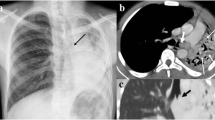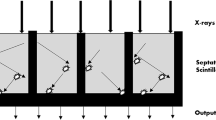Abstract
In this prospective study, we set out to determine the accuracy of low-dose computerized tomography (LDCT) of the chest in intensive care patients. Fifteen adult intensive care patients were examined with a standard-dose CT protocol (average radiation dose = 6.7 mSv), chosen as the reference standard, followed by a non-contrast-enhanced LDCT protocol (average radiation dose = 0.59 mSv). Each examination was then read by two separate groups of radiologists blinded to both the purpose and the protocol of the study. In the small group examined, the results showed 100% accuracy in the diagnosis of pneumomediastinum, pericardial effusion, and pleural effusion, and 90% accuracy in the diagnosis of pneumothorax and consolidation. There were no false-positive findings, and the few false-negative findings were unlikely to lead to any clinical interventions. Our examination protocol, while providing a tenfold reduction of the radiation dose, nevertheless remained accurate enough for resolving certain clinical questions common in the intensive care patient. Thus, we suggest that protocols aimed at reducing the radiation dose in chest CT could be applied to the intensive care patient for resolving some specific questions, without compromising the diagnostic yield of the examinations.

Similar content being viewed by others
References
Snow N, Bergin KT, Horrigan TP (1990) Thoracic CT scanning in critically ill patients: information obtained frequently alters management. Chest 97:1467–1470
Mirvis SE, Tobin KD, Kostrubiak I, Belzberg H (1987) Thoracic CT in detecting occult disease in critically ill patients. AJR Am J Roentgenol 148:685–689
Bernard GR, Artigas A, Brigham KL, Carlet J, Falke K, Hudson L, Lamy M, Legall JR, Morris A, Spragg R (1994) The American−European Consensus Conference on ARDS. Definitions, mechanisms, relevant outcomes, and clinical trial coordination. Am J Respir Crit Care Med 149:818–824
Golding RP, Knape P, Strack van Schijndel RJ, de Jong D, Thijs LG (1998) Computed tomography as an adjunct to chest X-rays of intensive care unit patients. Crit Care Med 16:211–216
Gattinoni L, Vagginelli F, Carlesso E, Taccone P, Conte V, Chiumello D, Valenza F, Caironi P, Pesenti A (2003) Prone−Supine Study Group. Decrease in PaCO2 with prone position is predictive of improved outcome in acute respiratory distress syndrome. Crit Care Med 31:2727–2733
Trotman-Dickenson B (2003) Radiology in the Intensive Care Unit (Part 2). J Intensive Care Med 18:239–252
Diederich S, Lenzen J (2000) Radiation exposure associated with imaging of the chest: comparison of different radiographic and computed tomography techniques. Cancer 89:2457–2460
Kubo T, Lin PJ, Stiller W, Takahashi M, Kauczor HU, Ohno Y, Hatabu H (2008) Radiation dose reduction in chest CT: a review. AJR Am J Roentgenol 190:335–343
Molina PL, Hiken JN, Glazer HS (1996) Imaging evaluation of obstructive atelectasis. J Thorac Imaging 11:176–186
Strandberg A, Hedenstierna G, Tokics L, Lundquist H, Brismar B (1986) Densities in dependent lung regions during anaesthesia: atelectasis or fluid accumulation? Acta Anaesthesiol Scand 30:256–259
Lynch L, Bowen M, Malone L (1994) Patient exposure to ionising radiation in the intensive care unit due to portable chest radiography. Ir J Med Sci 163:136–137
Kim PK, Gracias VH, Maidment AD, O'Shea M, Reilly PM, Schwab CW (2004) Cumulative radiation dose caused by radiologic studies in critically ill trauma patients. J Trauma 57:510–514
Björkdahl P, Nyman U (2010) Using 100- instead of 120-kVp computed tomography to diagnose pulmonary embolism almost halves the radiation dose with preserved diagnostic quality. Acta Radiol 51:260–270
Holmquist F, Hansson K, Pasquariello F, Björk J, Nyman U (2009) Minimizing contrast medium doses to diagnose pulmonary embolism with 80-kVp multidetector computed tomography in azotemic patients. Acta Radiol 50:181–193
Desai SR (2002) Acute respiratory distress syndrome: imaging of the injured lung. Clin Radiol 57:8–17
Author information
Authors and Affiliations
Corresponding author
Rights and permissions
About this article
Cite this article
Börjesson, J., Latifi, A., Friman, O. et al. Accuracy of low-dose chest CT in intensive care patients. Emerg Radiol 18, 17–21 (2011). https://doi.org/10.1007/s10140-010-0895-6
Received:
Accepted:
Published:
Issue Date:
DOI: https://doi.org/10.1007/s10140-010-0895-6




